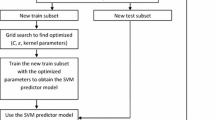Abstract
The growing interest in skateboarding as a competitive sport requires new motion analysis approaches and innovative ways to portray athletes’ results as previous techniques in the identification of the tricks was often inadequate in providing accurate evaluation during competition. Therefore, there is a need to introduce an unprejudiced method of evaluation in skateboarding competitions. This paper presents the classification of five different skateboarding tricks (Ollie, Kickflip, Frontside 180, Pop Shove-it, and Nollie Frontside Shove-it) through the identification os significant frequency-domain signals collected via Inertial Measurement Unit (IMU) and the use of machine learning models. One male skateboarder (age: 23 years old) performed five different tricks repeatedly for several times. The time-domain data acquired from the IMU were converted to frequency-domain by employing Fast Fourier Transform (FFT) and a number of statistical features (mean, kurtosis, skewness, standard deviation, root mean square and peak-to-peak corresponding to x-y-z-axis of the IMU) were then extracted. Significant features were then identified from the Information Gain (IG) scoring. It was shown from the study that the Naïve Bayes (NB) classifier is able to acquire the highest classification accuracy of 100% on the test data compared to the other evaluated classifiers, namely Artificial Neural Network (ANN) and Support Vector Machine (SVM), by utilising the selected features, suggesting that the proposed methodology could provide an objective-based evaluation of the tricks.
Access this chapter
Tax calculation will be finalised at checkout
Purchases are for personal use only
Similar content being viewed by others
References
Abdullah MA, Ibrahim MAR, Shapiee MNA Bin, Mohd Razman MA, Musa RM, Abdul Majeed APP (2020) The classification of skateboarding trick manoeuvres through the integration of IMU and machine learning. In: Lecture Notes in Mechanical Engineering. Springer, pp 67–74
Groh BH, Kautz T, Schuldhaus D (2015) IMU-based trick classification in skateboarding. KDD Work Large-Scale Sport Anal
Groh BH, Fleckenstein M, Kautz T, Eskofier BM (2017) Classification and visualization of skateboard tricks using wearable sensors. Pervasive Mob Comput 40:42–55
Anand A, Sharma M, Srivastava R, Kaligounder L, Prakash D (2018) Wearable motion sensor based analysis of swing sports. In: Proceedings—16th IEEE international conference on machine learning and applications ICMLA 2017 2018-January, pp 261–267. https://doi.org/10.1109/ICMLA.2017.0-149
Connaghan D, Kelly P, O’Connor NE, Gaffney M, Walsh M, O’Mathuna C (2011) Multi-sensor classification of tennis strokes. Proceedings IEEE Sensors, pp 1437–1440. https://doi.org/10.1109/ICSENS.2011.6127084
Corrêa NK, de Lima JCM, Russomano T, dos Santos MA, Corrêa NK, de Lima JCM, Russomano T, dos Santos MA (2017) Development of a skateboarding trick classifier using accelerometry and machine learning. Res Biomed Eng 33:362–369. https://doi.org/10.1590/2446-4740.04717
Friday H, Ying T, Mujtaba G, Al-garadi MA (2019) Data fusion and multiple classifier systems for human activity detection and health monitoring: review and open research directions 46:147–170. https://doi.org/10.1016/j.inffus.2018.06.002
Gani O, Fayezeen T, Povinelli RJ, Smith RO, Arif M, Kattan AJ, Iqbal S (2019) A light weight smartphone based human activity recognition system with high accuracy. J Netw Comput Appl 141:59–72. https://doi.org/10.1016/j.jnca.2019.05.001
Groh BH, Fleckenstein M, Eskofier BM (2016) Wearable trick classification in freestyle snowboarding. BSN 2016—13th annual body sensor network conference, pp 89–93. https://doi.org/10.1109/BSN.2016.7516238
Holleczek T, Schoch J, Arnrich B, Tröster G (2010) Recognizing turns and other snowboarding activities with a gyroscope. In: Proceedings—international symposium wearable computer ISWC. https://doi.org/10.1109/ISWC.2010.5665871
Hölzemann A, Van Laerhoven K Using wrist-worn activity recognition for basketball game analysis. https://doi.org/10.1145/3266157.3266217
Iwase T, Nozaki Y, Yoshikawa M (2015) Detection technique for hardware Trojans using machine learning in frequency domain. 2015 IEEE 4th global conference on consumer electronics, pp 185–186. https://doi.org/10.1109/GCCE.2015.7398569
Ashqar HI, Almannaa MH, Elhenawy M, Rakha HA, House L (2019) Smartphone transportation mode recognition using a hierarchical machine learning classifier and pooled features from time and frequency domains. IEEE Trans Intell Transp Syst 20:244–252. https://doi.org/10.1109/TITS.2018.2817658
Stewart TOM, Narayanan A, Hedayatrad L, Neville J, Mackay L, Duncan S (2018) A dual-accelerometer system for classifying physical activity in children and adults, pp 2595–2602. https://doi.org/10.1249/MSS.0000000000001717
Lei S (2012) A feature selection method based on information gain and genetic algorithm. Int Conf Comput Sci Electron Eng 2:355–358. https://doi.org/10.1109/ICCSEE.2012.97
Acknowledgements
The authors would like to acknowledge the Ministry of Education, Malaysia and Universiti Malaysia Pahang for supporting and funding this research via FRGS/1/2019/TK03/UMP/02/6 (RDU1901115).
Author information
Authors and Affiliations
Corresponding author
Editor information
Editors and Affiliations
Rights and permissions
Copyright information
© 2020 Springer Nature Singapore Pte Ltd.
About this paper
Cite this paper
Ibrahim, M.A.R., Shapiee, M.N.A., Abdullah, M.A., Razman, M.A.M., Musa, R.M., Abdul Majeed, A.P.P. (2020). The Classification of Skateboarding Trick Manoeuvres: A Frequency-Domain Evaluation. In: Mohd Razman, M., Mat Jizat, J., Mat Yahya, N., Myung, H., Zainal Abidin, A., Abdul Karim, M. (eds) Embracing Industry 4.0. Lecture Notes in Electrical Engineering, vol 678. Springer, Singapore. https://doi.org/10.1007/978-981-15-6025-5_17
Download citation
DOI: https://doi.org/10.1007/978-981-15-6025-5_17
Published:
Publisher Name: Springer, Singapore
Print ISBN: 978-981-15-6024-8
Online ISBN: 978-981-15-6025-5
eBook Packages: Mathematics and StatisticsMathematics and Statistics (R0)




